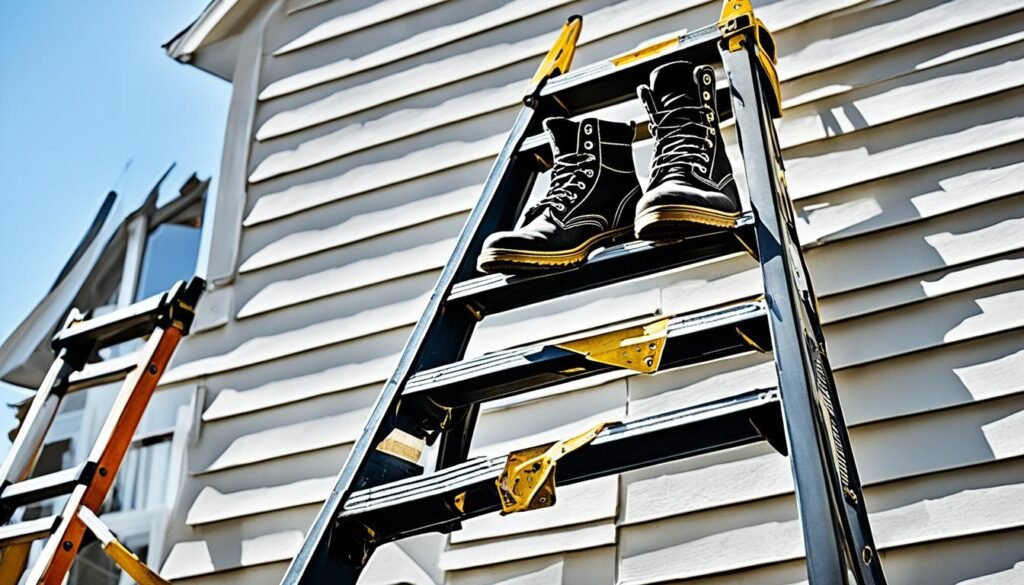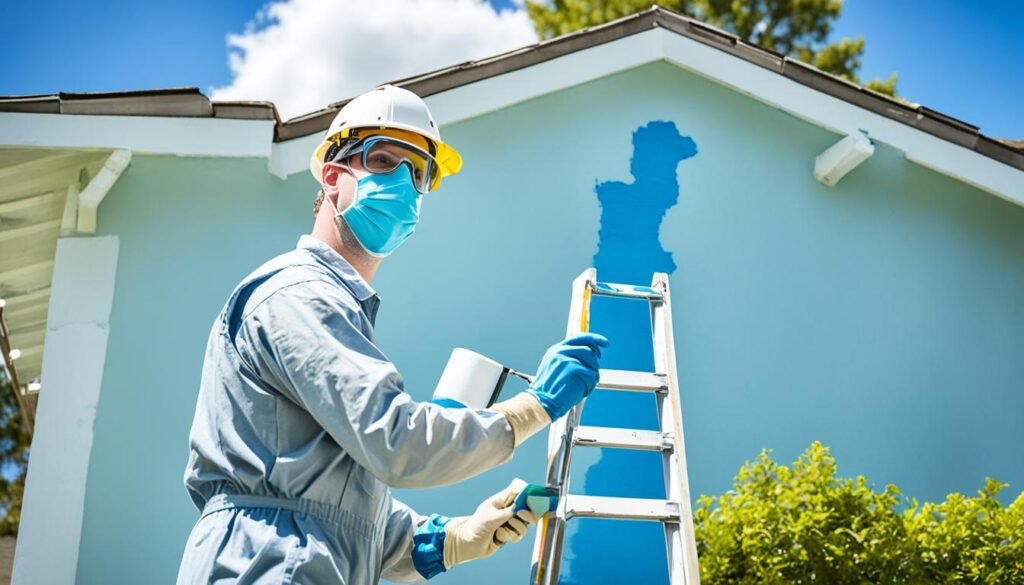Did you know that over 50% of homeowners in the United States prefer to tackle their exterior painting projects on their own? It’s no surprise, as DIY painting can be a cost-effective way to give your home a fresh new look. However, it’s crucial to prioritize safety when taking on such a task. From ladder accidents to chemical exposure, there are potential risks involved in DIY exterior painting that you need to be aware of. In this article, we’ll provide you with essential safety tips and tricks to ensure a successful and accident-free painting experience.
Key Takeaways:
- Prioritize safety when embarking on a DIY exterior painting project.
- Inspect and maintain your ladder to minimize the risk of falls and injuries.
- Invest in personal protective equipment (PPE), such as a chemical-resistant suit and respirator, to protect yourself from fumes and particles.
- Properly prepare your space by identifying potential hazards and protecting your surroundings from paint spills.
- Dispose of paint and cleanup materials responsibly to ensure environmental safety.
Ladder Safety Tips
When working on your exterior painting project, using a ladder is often necessary to reach high areas. However, it’s crucial to prioritize ladder safety to minimize the risk of accidents and injuries. Follow these ladder safety tips to ensure a smooth and safe painting experience:
- Inspect the ladder before each use: Before stepping onto your ladder, thoroughly inspect it for any signs of damage or wear. Check the rungs, hinges, and stabilizers to ensure they are secure and in good condition.
- Place the ladder on a solid surface: Make sure your ladder is set on a stable and level surface. Avoid placing it on uneven or slippery ground to prevent accidents.
- Maintain the proper placement ratio: To ensure stability and balance, follow the 4-to-1 rule when placing your ladder. For every four feet of ladder height, the base should be one foot away from the surface it rests against.
By practicing ladder safety and following these guidelines, you can greatly reduce the risk of falls and injuries during your exterior painting project. Remember, if you’re not comfortable working on a ladder or if the project requires more complex equipment, it’s always best to hire reliable exterior painters or local exterior painting contractors with top-rated exterior painting services. They have the expertise and experience to tackle the job safely and efficiently.
Table: Ladder Safety Tips
| Tips | Description |
|---|---|
| Inspect the ladder | Thoroughly inspect the ladder for any signs of damage or wear before each use. |
| Place on a solid surface | Ensure the ladder is placed on a stable and level surface to prevent slipping or tipping. |
| Maintain proper placement ratio | Follow the 4-to-1 rule for ladder placement to ensure stability and balance. |

Personal Protective Equipment (PPE)
When it comes to painting the exterior of your home, safety should always be a top priority. Investing in the right personal protective equipment (PPE) is essential to ensure your well-being throughout the painting process. By wearing proper gear, you can protect yourself from harmful fumes and particles, while also achieving a high-quality paint job that will enhance the look of your home.
Chemical-Resistant Suit
One of the key components of PPE for exterior painting is a chemical-resistant suit. This specialized suit provides a layer of protection against paint splatters, chemicals, and other hazardous substances. Look for a suit made from durable materials that offer full-body coverage. Ensure a proper fit to maximize comfort and usability.
Respirator
A reliable respirator is another crucial piece of PPE. It filters out harmful airborne particles and fumes, preventing you from inhaling potentially toxic substances. Opt for a respirator designed specifically for paint and chemical fumes to ensure optimal protection. Make sure to follow the manufacturer’s instructions for use and maintenance.
By wearing a quality chemical-resistant suit and respiratory mask, you can confidently tackle your exterior painting project, knowing that your health and safety are well-protected. Remember, an experienced exterior painting team understands the importance of PPE and will invest in these safety measures to deliver a high-quality paint job.
| PPE Equipment | Benefits |
|---|---|
| Chemical-Resistant Suit | Provides full-body protection against paint splatters and chemicals |
| Respirator | Filters out harmful fumes and particles, ensuring safe and clean air |
When it comes to exterior painting, don’t compromise on safety or the quality of the job. Trust the expertise of experienced exterior painting professionals who understand the importance of using personal protective equipment. They have the knowledge, skills, and equipment to deliver a high-quality paint job while prioritizing safety at every step of the process.

Preparing Your Space
Before starting your DIY exterior painting project, take the time to properly prepare your space. This crucial step will help ensure a smooth and successful painting experience. Here are some key considerations:
Inspect the Surroundings
Before setting up your painting equipment, thoroughly inspect the surroundings of your property. Identify potential hazards such as power lines, trees, or other obstacles that could interfere with your ladder placement or painting process. It’s important to ensure a safe working environment to prevent accidents and injuries.
Protect Walkways and Landscaping
Paint spills and splatters can cause damage to walkways, plants, and landscaping. To avoid any unwanted mess, take the necessary precautions to protect these areas. Cover walkways with drop cloths or plastic sheeting, and use painter’s tape and plastic covers to shield plants and landscaping from paint. This will help minimize any accidental damage and keep your property looking pristine.
Plan for Paint Disposal
Proper paint disposal is an important aspect of preparing your space. Consider how you will handle any excess paint or paint cans. Check with your local waste management facility or household hazardous waste center for guidelines on disposing of paint properly. By following the recommended disposal methods, you can protect the environment and prevent any potential hazards.
Secure Your Tools and Equipment
Before you begin painting, make sure your tools and equipment are secure and easily accessible. Keep your brushes, rollers, paint cans, and other supplies organized in a safe and convenient location. This will help streamline your painting process and ensure that you have everything you need within reach.
Essential Steps for Preparing Your Space
| Step | Description |
|---|---|
| 1 | Inspect the surroundings for potential hazards |
| 2 | Protect walkways, plants, and landscaping from paint spills |
| 3 | Plan for proper paint disposal |
| 4 | Secure your tools and equipment |
Proper Cleanup and Paint Disposal
Once you have completed your exterior painting project, it is important to clean up properly to ensure a safe and tidy environment. Using the right products for paint cleanup can make the process easier and more efficient. Here are some steps to help you properly clean up after painting:
Cleaning Tools
- Use a bucket filled with warm water and mild detergent to clean your brushes and rollers. Scrub them gently to remove any excess paint.
- For oil-based paints, use paint thinner or mineral spirits to clean your tools. Follow the manufacturer’s instructions for proper use and disposal of these materials.
- Wipe down any paint spills or drips on surfaces using a damp cloth or sponge.
Proper Paint Disposal
It is essential to dispose of any leftover paint properly to protect the environment and prevent potential hazards. Here are some guidelines to follow:
- Check with your local household hazardous waste center to find out the proper disposal methods for paint in your area. They may have specific guidelines for recycling or disposing of paint.
- If you have a small amount of leftover paint, consider using it for touch-ups or donate it to a local community organization or charity.
- If the paint cannot be reused or donated, ensure it is sealed properly in its original container and labeled for future reference.
- Always follow local regulations for paint disposal and never pour paint down the drain or into the ground.
Proper cleanup and paint disposal are important steps to ensure a safe and environmentally friendly completion of your exterior painting project. By following these guidelines, you can help minimize waste and protect your surroundings.
| Benefits of Proper Cleanup and Paint Disposal |
|---|
| 1. Environmental Protection By disposing of paint properly, you prevent contamination of soil, water sources, and the surrounding ecosystem. |
| 2. Safety Cleaning up paint spills and drips ensures a safe environment, reducing the risk of slips or falls due to slippery surfaces. |
| 3. Recyclability Some paint can be recycled and used for future projects, reducing waste and promoting sustainable practices. |
| 4. Compliance with Regulations Properly disposing of paint prevents legal and regulatory issues that may arise from improper waste management. |
Conclusion
Exterior painting can be a rewarding DIY project, allowing you to transform the look of your home and give it a fresh new appeal. However, it is crucial to prioritize safety throughout the process to ensure a successful and accident-free painting experience.
By following the essential safety tips mentioned in this article, you can protect yourself and minimize the risk of accidents. Inspect your ladder before use, practice ladder safety, and wear the appropriate personal protective equipment (PPE) such as a chemical-resistant suit and respirator.
If you prefer to leave the painting to professionals, consider hiring an experienced exterior painting team. They have the expertise, tools, and knowledge to provide you with a high-quality paint job without compromising on safety. Prioritizing safety while transforming the look of your home is crucial to protect yourself and achieve the desired results.
Remember, whether you choose to tackle the project yourself or hire professionals, safety should always be your top priority. Protect yourself, follow the safety guidelines, and enjoy the process of transforming your home with a fresh coat of paint.
FAQ
What are some important safety tips for DIY exterior painting?
When taking on a DIY exterior painting project, it is important to prioritize safety. Here are some essential safety tips to follow:- Inspect and secure your ladder before each use.- Ensure your ladder is placed on a solid surface.- Maintain the proper placement ratio between the ladder and the house.- Wear personal protective equipment (PPE) such as a chemical-resistant suit and respirator.
Why is ladder safety important during exterior painting?
Ladder safety is crucial during exterior painting because it helps minimize the risk of accidents and injuries. By following ladder safety guidelines, such as inspecting the ladder, placing it on a solid surface, and maintaining the proper placement ratio, you can prevent falls and ensure a safe painting experience.
What personal protective equipment (PPE) should I wear for exterior painting?
When painting the exterior of your home, it is important to wear the right personal protective equipment (PPE). Invest in a quality chemical-resistant suit and a respirator to protect yourself from harmful fumes and particles. This will help ensure your safety and health while achieving a high-quality paint job.
How should I prepare my space before starting a DIY exterior painting project?
Properly preparing your space is vital before starting a DIY exterior painting project. Here are some steps to follow:- Inspect the surroundings for potential hazards such as power lines or trees that may interfere with your ladders.- Consider how you will protect walkways, plants, and landscaping from paint spills.By planning and preparing in advance, you can avoid accidents and minimize damage to your property.
How should I clean up after an exterior painting project?
Cleaning up after an exterior painting project is essential for a safe and tidy environment. Use the right products for paint cleanup to make the process easier and more efficient. If you have any leftover paint, dispose of it properly by checking with your local household hazardous waste center. This will help protect the environment and prevent any potential hazards.

No comment yet, add your voice below!